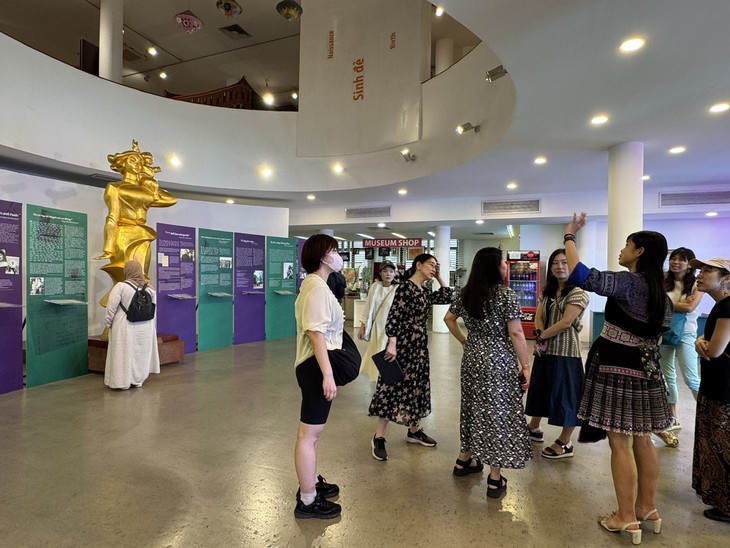 The main hall of the Vietnamese Women's Musum (photo: Cam Thi) The main hall of the Vietnamese Women's Musum (photo: Cam Thi) |
The Vietnamese Women’s Museum, founded in 1987, is known for preserving and displaying tangible and intangible cultural heritages of Vietnamese women and also as a cultural center where Vietnamese and foreign women can exchange cultural activities related to equality, development and peace. In the past few years, the museum has organized multiple community activities to attract domestic and foreign visitors.
To mark International Museum Day (May 18), themed “The Future of Museums in Rapidly Changing Communities,” the museum held a workshop on the traditional beeswax painting art of the Mong ethnic group on brocade. The event demonstrated how museums can evolve and actively contribute to social, technological, and environmental changes.
The Vietnamese Women’s Museum is one of Hanoi’s most renowned cultural destinations, located in the heart of the capital. It offers an insightful look into the lives, roles, and contributions of Vietnamese women throughout history and across diverse ethnic communities. With a rich collection of artifacts, photographs, and multimedia displays, the museum highlights themes such as family life, work, fashion, and women’s participation in wartime. It also regularly hosts exhibitions and community programs that promote gender equality and cultural heritages, making it a dynamic space for both locals and international visitors.
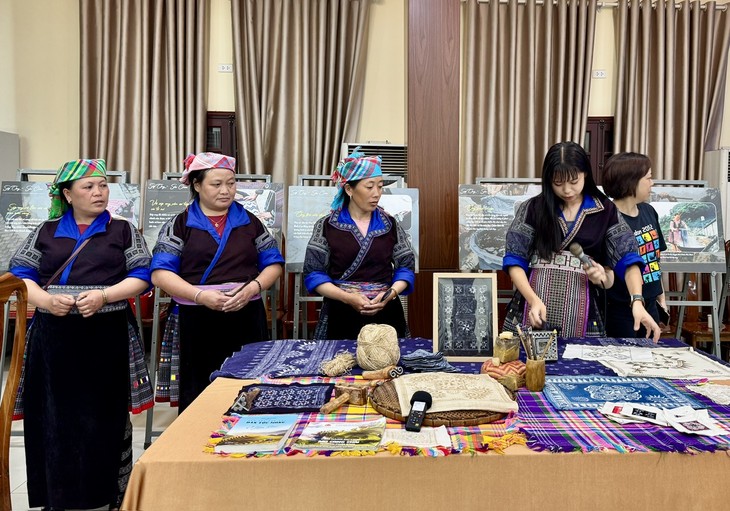 Yuka Three Mong artisans come from Yen Bai province to guide a workshop at the Vietnamese Women's Museum. (photo: Cam Thi) Yuka Three Mong artisans come from Yen Bai province to guide a workshop at the Vietnamese Women's Museum. (photo: Cam Thi) |
Three Mong artisans traveled from De Thang hamlet in Mu Cang Chai district, Yen Bai province, to the Vietnamese Women’s Museum to guide 20 participants, mostly Japanese, through a hands-on experience of creating beeswax patterns on fabric, a distinctive Mong women's craft.
Artisan Ly Thi Ninh, head of Che Cu Nha Brocade Weaving Cooperatives, introduced the beeswax painting art to the participants and explained what they would be doing with the materials laid out on the tables: pieces of white cloth, pens with bronze tips, cups of melted beeswax kept warm over candles, and images of traditional Mong motifs. While guiding their drawing attempts, Ninh also told them about the Mong culture:
“Beeswax painting is a time-honored tradition of the Mong people. We draw these motifs on our clothing and they are deeply ingrained in our minds, passed down through generations. They often depict elements from nature and daily life, such as chicken feet, buffalos, horses, stars, mountains, and other natural forms,” said. Ninh.
The participants came from various age groups. Some arrived alone, while others came with friends or family members. They were fascinated by the process of selecting motifs and trying their hand at batik painting, using bronze-tipped pens dipped in melted beeswax to draw on cloth. These hands-on workshops transformed the Vietnamese Women’s Museum into a lively and engaging cultural space.
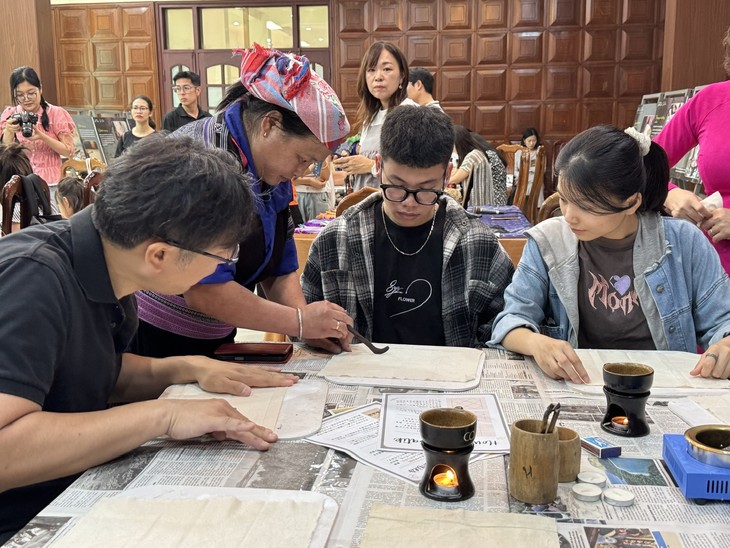 Artisan Ly Thi Ninh guides Japanese people to draw beeswax patterns on fabric. (photo: Cam Thi) Artisan Ly Thi Ninh guides Japanese people to draw beeswax patterns on fabric. (photo: Cam Thi) |
Japanese man, Tsuno Makota, said: “Even before this, I already liked this museum and had visited a few times. It’s a very meaningful event that introduces Mong culture, creates jobs, and allows them to sell their products and earn income. If the museum holds similar events in the future, I’ll definitely come again.”
"I learned that many Mong people, especially women, don't speak much Vietnamese. They have their own language and culture that have been preserved for hundreds of years. Their way of life is simple. Many of them are not yet familiar with modern technology. I want to better understand their culture and how they live in harmony with nature. I want to support them, not just by giving money, but by helping them find ways to earn an income so their families can live happily,” said Kota, a Japanese man who is working in Vietnam.
"I'm really interested in learning about art, especially from ethnic groups. This is my first time trying it, and I really enjoyed it. For people who don’t have the chance to travel to highland ethnic communities and experience their daily lives, this offers a good opportunity to get a taste of that right here in the capital," said Tran Thi Giang, a lawyer.
The workshop was a collaboration between the Vietnamese Women’s Museum and the Japan International Cooperation Agency’s voluntary program to support the development of tourism in Vietnam.
Yuka Takada, a volunteer with the JICA voluntary program, lived for a year with the Mong in Mu Cang Chai, where she helped the women diversify their products to sell as souvenirs. During that time, she guided more than 100 Japanese tourists to Yen Bai to experience Mong culture. Bringing a group of Japanese visitors to the beeswax painting workshop in Hanoi was another opportunity to promote Mong culture to visitors who might not have a chance to visit a Mong hamlet.
“I voluntarily help introduce Mong culture to tourists. The Mong have a rich cultural heritage, but it’s not well known among Japanese people, who are more familiar with Vietnam’s terraced rice fields. When more people get to know the Mong culture, it makes me happy and tourism becomes more meaningful,” said Yuka.
Akiko Kobayashi, JICA’s Collaborator for the Voluntary Program, said: “I’ve been to Mù Cang Chải three times already. It’s a fascinating place. Their culture is so different from that of the Kinh people, from language and food to family relationships. I don’t know why, but I feel a deep connection with their culture. Many people living in Hanoi don’t really know much about the Mong culture. Exhibitions like this are meaningful. Many ethnic groups still rely mainly on agriculture for their income. But they have rich cultures that could be developed into tourism.”
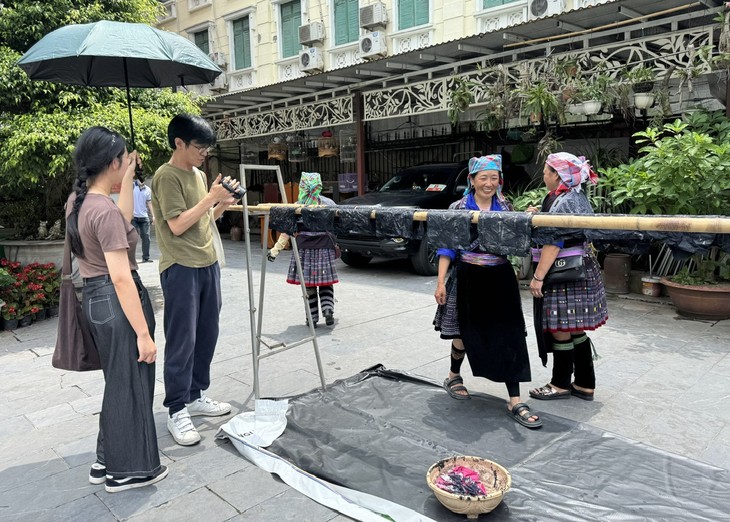 The Mong artisans dry the paintings at the front yard of the Vietnamese Women's Museum. (photo: Cam Thi) The Mong artisans dry the paintings at the front yard of the Vietnamese Women's Museum. (photo: Cam Thi) |
Artisan Ly Thi Ninh talked about changes in her hamlet and the Brocade Weaving Cooperatives since they started participating in Mong art workshops. “When I joined a workshop to introduce the traditional crafts of the Mong people to foreigners, I found out that they’re really interested in our culture. When they go home, they tell their friends about us, and more visitors come. Many Mong people in our hamlet struggle to make a living, but with more tourists, they have a chance to sell their handmade products. We’re very happy,” said Ninh.
Le Cam Nhung, head of the Vietnam Women Museum’s Media and External Relations, said that in recent years the Museum has reached out to ethnic communities, especially women and children, to help them in their journey toward sustainable development. The museum has collaborated with various partners on projects and programs that serve the community.
Ms. Nhung said: “The Vietnamese Women’s Museum has worked with departments and agencies of the Vietnam Women’s Union to implement Program 8, a national target program in accordance with the UN Sustainable Development Goals, to help women and children in ethnic minority communities overcome gender barriers and affirm their identity. The museum has connected ethnic communities, such as those practicing batik beeswax painting, with customers while preserving these valuable cultural heritages.”
The Museum has collaborated with RMIT University Vietnam on a development project for ethnic women in Pa Co and Lac village in Hoa Binh province. They have connected students majoring in fashion design with ethnic women to co-create traditional handmade products with a modern twist—making them more appealing to modern consumers. This project has inspired young students to appreciate traditional values and raised their awareness about preserving and promoting those values. At the same time, it has encouraged ethnic minority women to catch up with modern trends.
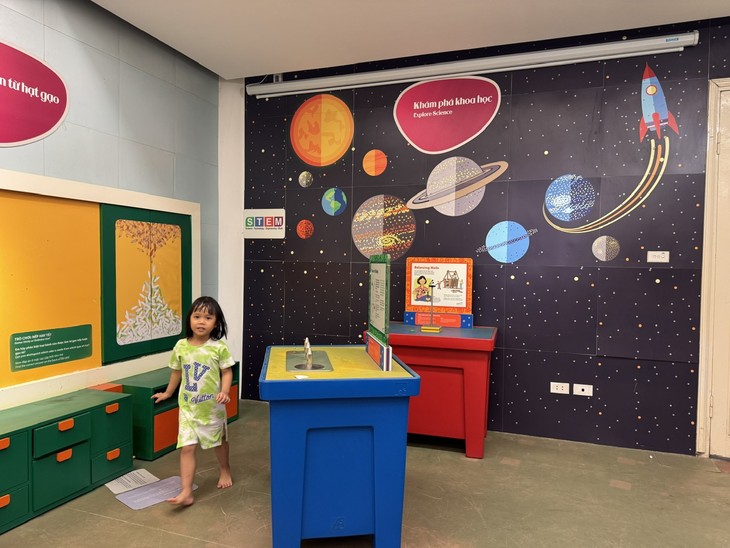 Scientic exploration space for children at the Vietnamese Women's Museum (photo: Cam Thi) Scientic exploration space for children at the Vietnamese Women's Museum (photo: Cam Thi) |
American visitor Alexia Anderson comes regularly to the Vietnamese Women’s Museum as part of her academic program in Vietnam. “I've been all the way up. I started from the top and worked my way down. It's modern but it brings in traditional aspects, which is very interesting. Along with it being insightful about the work that women have put together, supporting each other, throughout history, I feel very proud and wish that more people would create museums based on women's achievements and suffering. It's very insightful to know the differences of the past, the future, and the present. I feel that it was very encompassing of all different types of tradition and culture in Vietnam.”
Ms. Nhung said ethnic communities possess a wealth of intangible assets, such as traditional crafts and cuisine, which are still preserved locally. If we’re not careful to preserve and promote them to the wider public, much of this heritage could be lost. “This effort not only helps preserve and highlight cultural values but also creates livelihoods, generates income, and enables them to share their stories with tourists and introduce their culturally rich products to wider audiences. I believe that through culture, we can also promote sustainable livelihoods."
Besides the permanent exhibits, the Vietnamese Women’s Museum has a shop on its premises that sells handmade products created by ethnic minority women. It organizes a variety of discussions, exchanges, and workshops at schools and in local communities. These activities help ethnic minority communities recognize their own potential, shift traditional mindsets and practices, and empower women and children to realize their dreams.
Whether through hands-on workshops, live performances, or community events, museums are proving that the past comes alive when people are part of the story.